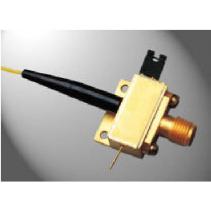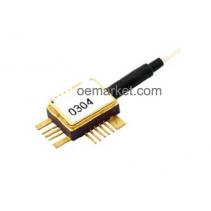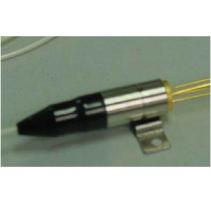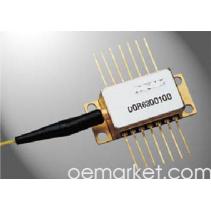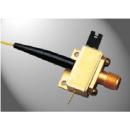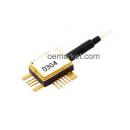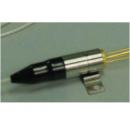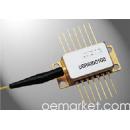- Home
- Opto-Electronics
Read What Others Are Saying
Displaying 13 to 18 (of 18 reviews)-
by Technology Explained Date Added: Tuesday 07 February, 2012
10GHz Bandwidth PIN Photodetector
High speed PIN photodiodes To reduce the response time of a photodiode, the capacitance of the PN junction must be reduced. One of the ways to do that is to expand the depletion layer. The structure of the PN junction is designed to have a large N...Rating: [5 of 5 Stars!]
[5 of 5 Stars!] 
-
by Technology Explained Date Added: Monday 06 February, 2012
Silicon Photodiode - 650nm
Silicon photodiode is made from a single crystal Si wafer. The band gap of silicon fits in the energy level from visible light wavelengths to near infrared (400~1100nm). The photodiode is suitable to detect lights in that wavelength range. The res...Rating: [5 of 5 Stars!]
[5 of 5 Stars!] 
-
by Technology Explained Date Added: Monday 06 February, 2012
10Gb/s Surface-Mount PIN/TIA Detector
10Gbps PIN-TIA has important role in today\'s ever growing fast optical fiber networks, especially in the FTTx sector. Continuous demand on internet bandwidth has driven the deployment of 10Gbps optical link to the edge of the network. At more wi...Rating: [5 of 5 Stars!]
[5 of 5 Stars!]
-
by Technology Explained Date Added: Sunday 05 February, 2012
1310nm or 1550nm DFB Laser - Coaxial Pigtail
\"DFB\" here means distributed feedback. DFB laser diode is an improved version of more conventional FP laser diode. The difference of a DFB laser is it has a periodically structured diffractive grating written in its active layer. The Bragg gr...Rating: [5 of 5 Stars!]
[5 of 5 Stars!] 
-
-11%by Technology Explained Date Added: Sunday 05 February, 2012
1310nm or 1550nm FP Laser - Coaxial Pigtail
The \"FP\" stands for Fabry-Perot. Fabry-Perot laser diode has very simple structure: two reflective mirrors and an active section between the mirrors. Most laser systems can be simplified as FP oscillators. FP laser diode is made by cleaving t...Rating: [5 of 5 Stars!]
[5 of 5 Stars!] 
-
-16%by Technology Explained Date Added: Sunday 05 February, 2012
1310nm DFB MQW Laser - High Power Analog Module
MQW stands for Multi-Quantum Well. Quantum well laser diode is developed from heterostructure laser diode. When the active layer of the heterostructure diode is extremely thin (around tens of nanometers), the electron levels in the active layer ar...Rating: [5 of 5 Stars!]
[5 of 5 Stars!]
-
by Technology Explained Date Added: Tuesday 07 February, 2012Rating:
 [5 of 5 Stars!]
[5 of 5 Stars!]10GHz Bandwidth PIN Photodetector
High speed PIN photodiodes To reduce the response time of a photodiode, the capacitance of the PN junction must be reduced. One of the ways to do that is to expand the depletion layer. The structure of the PN junction is designed to have a large N-type material. Usually the layer of the P-type material is very thin in order to have good sensitivity at the short wavelength range. Large N-type material ensures large depletion region is generated... 
-
by Technology Explained Date Added: Monday 06 February, 2012Rating:
 [5 of 5 Stars!]
[5 of 5 Stars!]Silicon Photodiode - 650nm
Silicon photodiode is made from a single crystal Si wafer. The band gap of silicon fits in the energy level from visible light wavelengths to near infrared (400~1100nm). The photodiode is suitable to detect lights in that wavelength range. The responsivity of a photodiode indicates how sensitive of the diode to the incident light. It is measured in photocurrent in amperes against the optical power on the diode in watts. Responsivity of the sil... 
-
by Technology Explained Date Added: Monday 06 February, 2012Rating:
 [5 of 5 Stars!]
[5 of 5 Stars!]10Gb/s Surface-Mount PIN/TIA Detector
10Gbps PIN-TIA has important role in today\'s ever growing fast optical fiber networks, especially in the FTTx sector. Continuous demand on internet bandwidth has driven the deployment of 10Gbps optical link to the edge of the network. At more widely deployed 2.5Gbps, PIN-TIA photodetectors are low-cost, and have very high sensitivity (low optical power required at the detector). This means the 2.5Gbps link can tolerate much higher optical lo...
-
by Technology Explained Date Added: Sunday 05 February, 2012Rating:
 [5 of 5 Stars!]
[5 of 5 Stars!]1310nm or 1550nm DFB Laser - Coaxial Pigtail
\"DFB\" here means distributed feedback. DFB laser diode is an improved version of more conventional FP laser diode. The difference of a DFB laser is it has a periodically structured diffractive grating written in its active layer. The Bragg grating is written within the laser cavity. Hence it forms a feedback \"mirror\" of the cavity. Unlike FP laser cavities, where a number of longitudinal modes are supported by the mirrors, grating only ... 
-
-11%by Technology Explained Date Added: Sunday 05 February, 2012Rating:
 [5 of 5 Stars!]
[5 of 5 Stars!]1310nm or 1550nm FP Laser - Coaxial Pigtail
The \"FP\" stands for Fabry-Perot. Fabry-Perot laser diode has very simple structure: two reflective mirrors and an active section between the mirrors. Most laser systems can be simplified as FP oscillators. FP laser diode is made by cleaving the facets of a semiconductor PN junction. The facets are naturally reflective because of the difference on refractive index of the semiconductor material and the air. Different high reflective and wav... 
-
-16%by Technology Explained Date Added: Sunday 05 February, 2012Rating:
 [5 of 5 Stars!]
[5 of 5 Stars!]1310nm DFB MQW Laser - High Power Analog Module
MQW stands for Multi-Quantum Well. Quantum well laser diode is developed from heterostructure laser diode. When the active layer of the heterostructure diode is extremely thin (around tens of nanometers), the electron levels in the active layer are split into discrete levels. This structure is called quantum well. The density of the electrons at the discrete energy levels is increased, which results in a lower laser threshold. Multiple q...
Displaying 13 to 18 (of 18 reviews)Our Offers
Contact Us
- Bitline System Pty. Ltd. 10 Fishburns Road, Galston, NSW 2159, Australia
- +61 2 98991412
- info@oemarket.com
oeMarket.com © 2024
-

